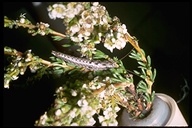|
|
click photo for larger file

Timema genevievae
|
Photographer: Unknown (CAS)
Organization: California Academy of Sciences
Collection: CalAcademy
ID: 9092 3191 3539 0053 (1999-11-04)Copyright © 1999 California Academy of Sciences
|
|
INFORMATION PROVIDED WITH THE PHOTO
|
date of photo Jun 1, 1994
latitude 37.34178 longitude -121.64410 max error distance 18109 meters
View on Google Maps.
horizontal datum World Geodetic System 1984 georeferencing source GeoLocatelocation
Highway 130 (Santa Clara County, California, US)order
Phasmatodea
class Insecta
CalAcademy slide # E 191photo category: Animal - Invertebrate-Insect
|
MORE INFORMATION ABOUT THIS ANIMAL
|
| View all photos in CalPhotos of Timema genevievae Check Google Images for Timema genevievae |
|
Reviewers' comments about this photo (sign in to review or add a comment about this photo)
| 1. | Reviewed by Paul Johnson Jan 21, 2006 |
| Action: changed name from "Unknown" to "Timema sp.
" |
| Reviewer's comments: | | | | "Clearly a data entry error." |
|
| 2. | Reviewed by Aaron Schusteff Jul 12, 2013 |
| Action: changed name from "Timema sp." to "Timema genevieve
" |
| Reviewer's comments: | | | | "The location, gestalt, and host plant (Adenostoma fasciculatum or "chamise") point clearly to species T. genevieve. This is a female, as can be seen from the form of the terminalia (for details, see the BugGuide Timema page).
The original description of T. genevieve appears in Rentz (1987), see "Print References" at bottom of the this page. Interestingly, this was the first parthenogenetic (i.e all female, asexually reproducing) species of Timema discovered. Four more parthenogenetic species have been found, out of a current total of 21 species for the genus. Research indicates T. genevieve has been a parthenogenetic lineage for a million years or more. See this interesting article for details." |
|
| 3. | Reviewed by Aaron Schusteff May 16, 2016 |
| Action: changed name from "Timema genevieve" to "Timema genevievae
" |
| Reviewer's comments: | | | | "I'm correcting two errors that appeared in my previous annotation:
1) The correct spelling of the epithet here is T. genevievae, rather than T. genevieve. That's the spelling used in the original description in the paper by Rentz. See for example, this link.
2) Rentz's paper was published in 1978, not 1987 (I made a transposition typo in my previous remark!)." |
|
|
|
Using this photo The thumbnail photo (128x192 pixels) on this page may be freely used for personal or academic purposes without prior permission under the Fair Use provisions of US copyright law as long as the image is clearly credited with © California Academy of Sciences.
Permission is granted to use the enlargement
for personal, academic, or non-profit purposes as long as
the user fills out the following form: https://forms.gle/R2ZUig8o8iYj4TrW9
and the image is clearly credited with
© California Academy of Sciences.
For higher resolution images or commercial use please
fill out this form: https://forms.gle/QKoVskQBcnYZPbrD6.
Please make sure to include the 16 digit ID number for the image.
|
|
|
